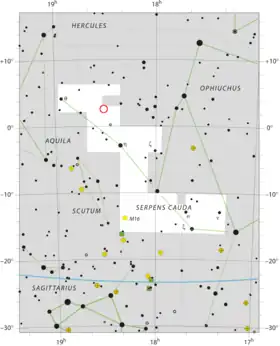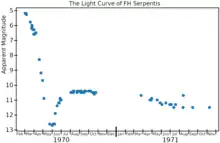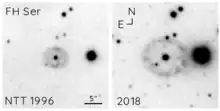 | |
| Observation data Epoch J2000.0 Equinox J2000.0 | |
|---|---|
| Constellation | Serpens |
| Right ascension | 18h 30m 47.0400s[1] |
| Declination | +02° 36′ 52.0264″[1] |
| Apparent magnitude (V) | 4.5 Max. 16.8 Min.[2] |
| Characteristics | |
| Variable type | Nova[2] |
| Astrometry | |
| Proper motion (μ) | RA: 2.060±0.142[1] mas/yr Dec.: −3.047±0.167[1] mas/yr |
| Parallax (π) | 0.9512 ± 0.0765 mas[1] |
| Distance | 1060+112 −68[2] pc |
| Other designations | |
| Database references | |
| SIMBAD | data |

FH Serpentis (Nova Serpentis 1970) was a nova, which appeared in the constellation Serpens in 1970. It reached magnitude 4.4.[5] It was discovered on February 13, 1970 by Minoru Honda located at Kurashiki, Japan.[6][7] Other astronomers later studied this nova, and calculated its distances based on the decay time of its light curves.[7]
Nova Serpentis was also observed by the NASA space observatory OAO-2 Stargazer, active from 1968 to 1973.[8]
The nova was important for science because it was one of the first to be observed in multiple wavelength bands including, infrared, visible, ultra-violet, and radio.[6] One of the observations that stood out was that it became brightest in the infrared 100 days after it was first discovered.[6]

A small emission nebula (shell) is visible around the star, which resembles a planetary nebula. Santamaria et al. examined images of the nebula taken in 1996 and 2018 and found that the shell is clearly expanding. It is slightly elliptical, with major and minor axes of 12.4×10.6 arc seconds (as of 2018) expanding at a rate of 0.125×0.109 arc seconds per year, implying a physical expansion rate of 630×540 km/sec.[9]
References
- 1 2 3 4 5 Brown, A. G. A.; et al. (Gaia collaboration) (August 2018). "Gaia Data Release 2: Summary of the contents and survey properties". Astronomy & Astrophysics. 616. A1. arXiv:1804.09365. Bibcode:2018A&A...616A...1G. doi:10.1051/0004-6361/201833051. Gaia DR2 record for this source at VizieR.
- 1 2 3 Schaefer, Bradley E. (2018). "The distances to Novae as seen by Gaia". Monthly Notices of the Royal Astronomical Society. 481 (3): 3033–3051. arXiv:1809.00180. Bibcode:2018MNRAS.481.3033S. doi:10.1093/mnras/sty2388. S2CID 118925493.
- ↑ "FH Serpentis". SIMBAD. Centre de données astronomiques de Strasbourg. Retrieved 2019-08-30.
- ↑ Strope, Richard J.; Schaefer, Bradley E.; Henden, Arne A. (July 2010). "Catalog of 93 Nova Light Curves: Classification and Properties". The Astronomical Journal. 140 (1): 34–62. arXiv:1004.3698. Bibcode:2010AJ....140...34S. doi:10.1088/0004-6256/140/1/34. S2CID 118537823.
- ↑ Templeton, Matthew (23 January 2012). "FH Ser (Nova Serpentis 1970)". AAVSO Website. American Association of Variable Star Observers. Retrieved 2 July 2014.
- 1 2 3 "FH Ser (Nova Serpentis 1970)". AAVSO. Retrieved 2020-12-16.
- 1 2 Borra, Ermanno F.; Andersen, Per H. (1970). "Photoelectric Observations of Nova Serpentis 1970". Publications of the Astronomical Society of the Pacific. 82 (489): 1070. Bibcode:1970PASP...82.1070B. doi:10.1086/129005.
- ↑ Joseph A. Angelo (2014). Spacecraft for Astronomy. Infobase Publishing. p. 20. ISBN 978-1-4381-0896-4.
- 1 2 Santamaria, E.; Guerrero, M.A.; Ramos-Larios, G.; Toala, J.A.; Sabin, L.; Rubio, G.; Quino-Mendoza, J.A. (March 2020). "Angular Expansion of Nova Shells". The Astrophysical Journal. 892 (1): 60. arXiv:2002.06749. Bibcode:2020ApJ...892...60S. doi:10.3847/1538-4357/ab76c5. S2CID 211132830.